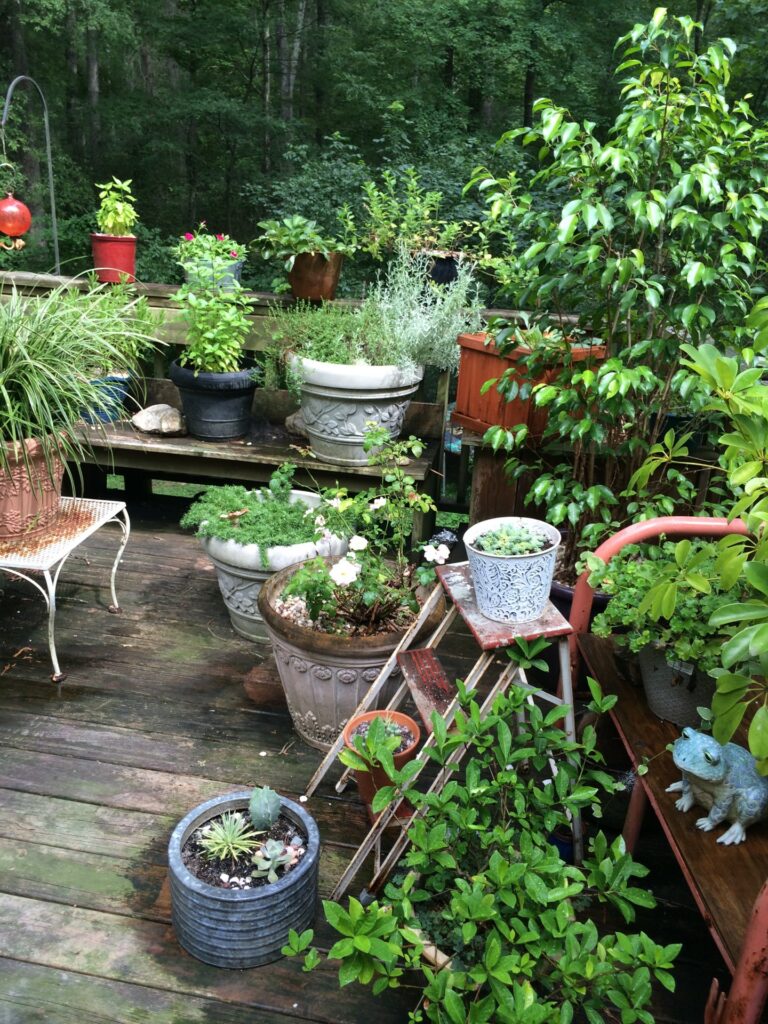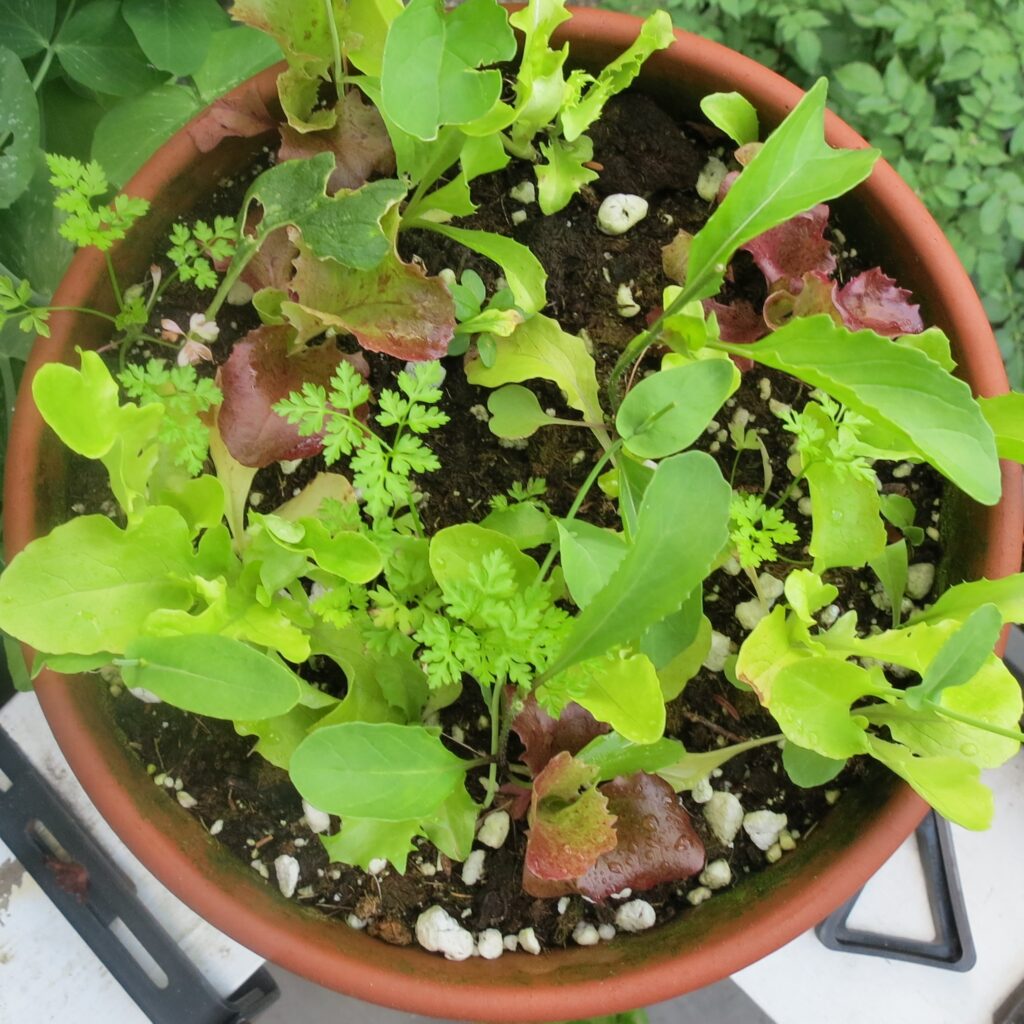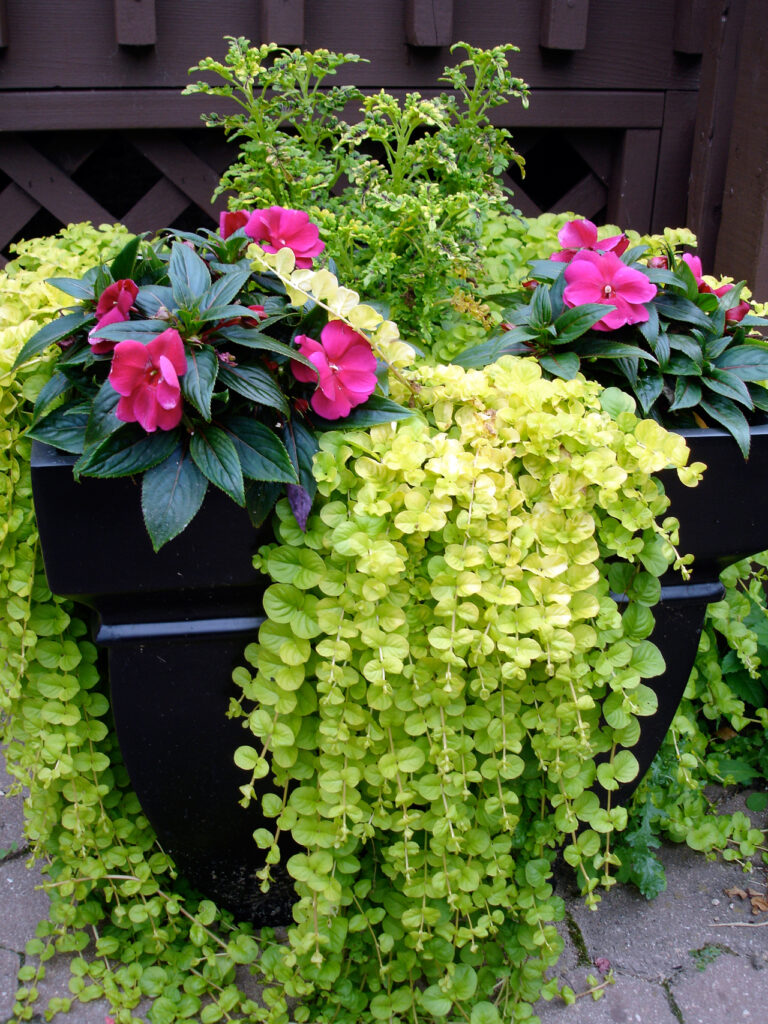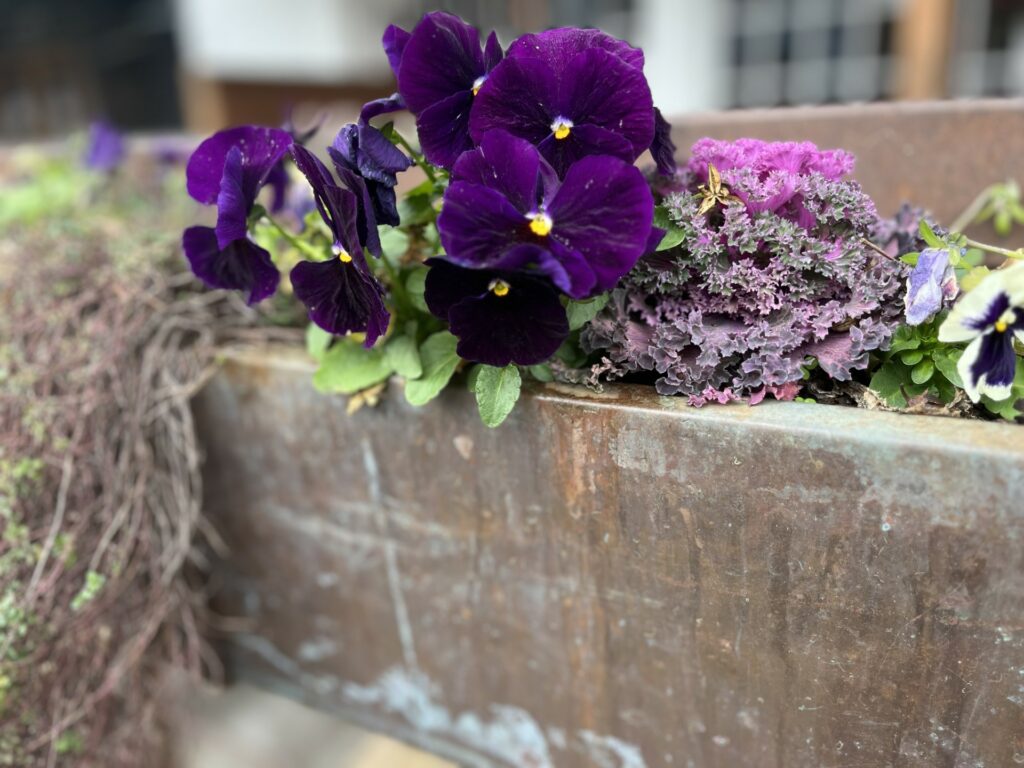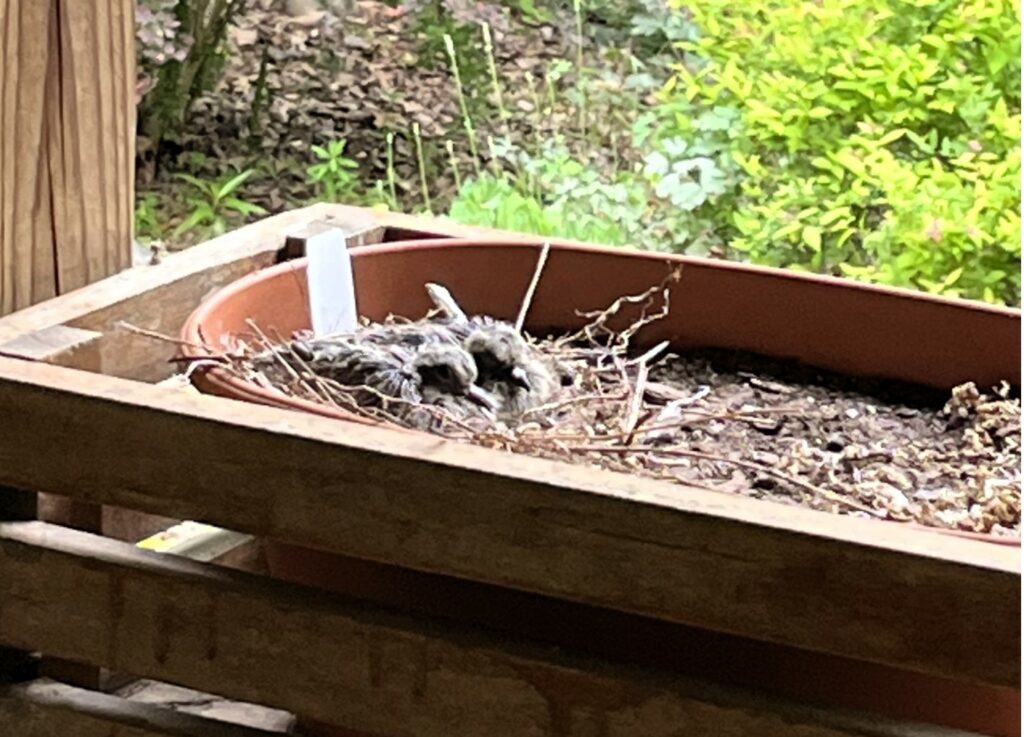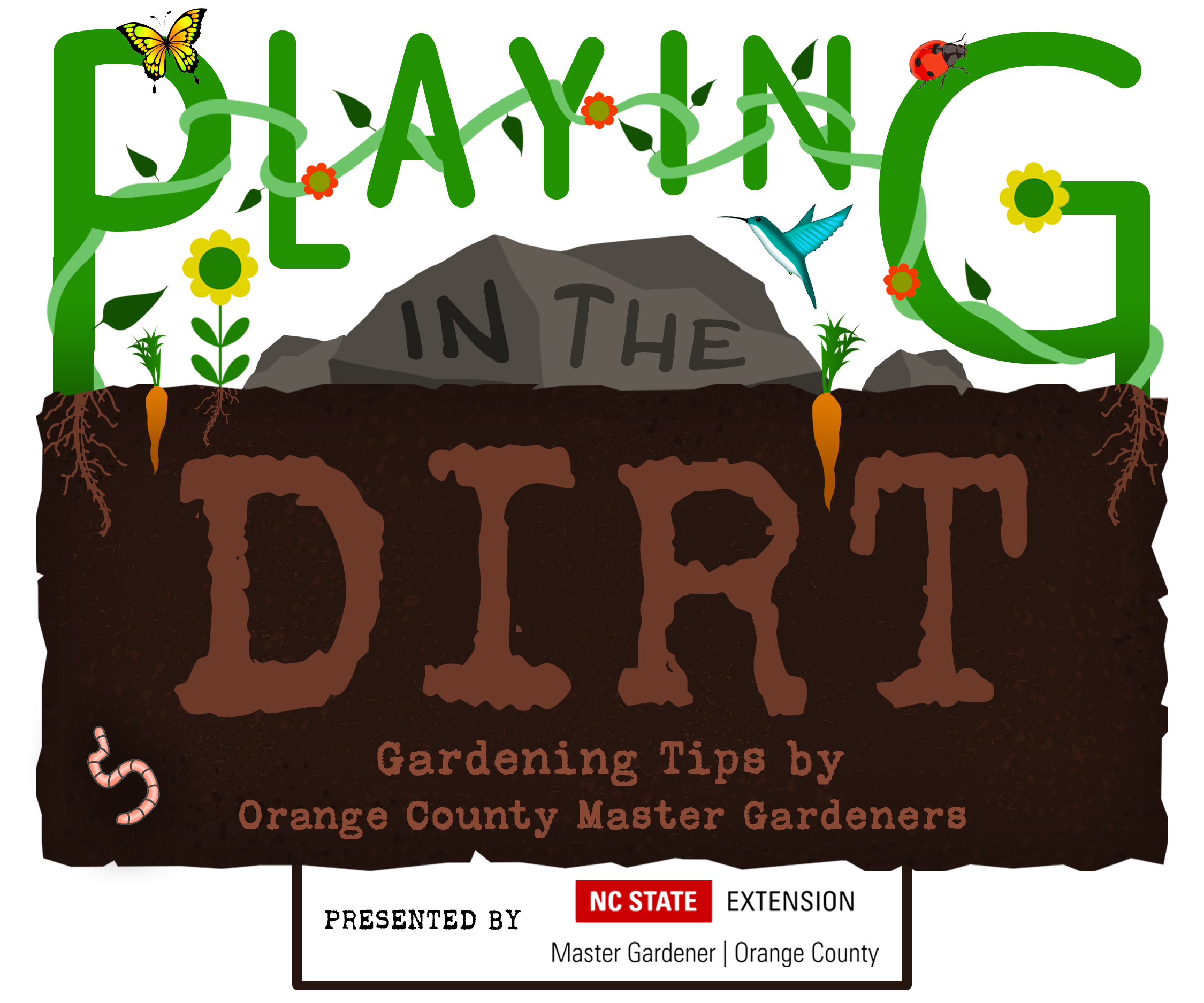
97.9 The Hill and Chapelboro.com have partnered with NC State Extension Master Gardener℠ volunteers of Orange County for “Playing in the Dirt,” a monthly column providing information and inspiration to gardeners of all skill levels! Check back on Chapelboro each month for a new subject – from our gardens to yours!
By Lynn Calder, Orange County Master Gardener℠ volunteer
Container gardening can provide many options for homeowners and renters who have outdoor space limitations. By planting in containers, you can enjoy a thriving garden on a deck, porch, patio or balcony even if you live in an apartment, condo or home on a very small lot.
Assess Your Available Light First
The mantra “right plant, right place” is critical when choosing plants to grow in these limited areas.
Light is one of the most critical elements for successful gardening — you must choose plants that will grow in your available light. The amount of light reaching decks, porches, patios and balconies is affected by the direction of the sun and the time of year and shade created by surrounding trees, rooflines and nearby buildings.
Tip for assessing sunlight: On a sunny day, monitor how much of your gardening space is in the sun and for how long. You could take a photo or make a sketch every hour or two from sunrise until sunset to record what time the sun reaches which part. The time of day is important to note because afternoon sun is hotter and more intense than morning sun. Repeat your sun-tracking as light patterns change during the seasons.
Once you’ve assessed your space for sunlight, check plant tags or seed packages for the plant’s sun/shade requirements, usually defined by the number of hours of sun the plant receives. For example, “full sun” generally means at least six hours of sunlight and “partial shade” is four to six hours of sunlight. See Defining Sun Requirements for Plants for more information.
Tip for finding plant options before you shop: The North Carolina Extension Gardener Plant Toolbox “find a plant page” provides search filters to find the right plant for any setting. You’ll be able to identify flowering, edible and foliage plants for your small space environment.
Other Environmental Factors
When gardening on a balcony, wind can be hotter and stronger than at ground level and can swirl in gusts up and around buildings. Wind quickly dries out plants and soil and strong gusts can break stems and topple lighter-weight pots. If your balcony is exposed to strong winds, the microclimates in sheltered corners may be the best spots to place containers.
Impermeable surfaces, such as parking areas, collect heat causing hotter and drier conditions in summer months. The soil in containers blasted with full sun all day will dry out quickly. If the space for your container garden is subject to these hot, dry conditions, consider installing a screen or blind to protect plants from direct sunlight. Remember to check for dryness as the containers will need frequent watering, perhaps even twice a day.
Containers and Plant Arrangement
Start with a clean container that is at least large enough for the plant’s roots and contains a drainage hole. Large lightweight planters are good choices because they hold more soil, making them less susceptible to drying out, heating up and being knocked over by wind.
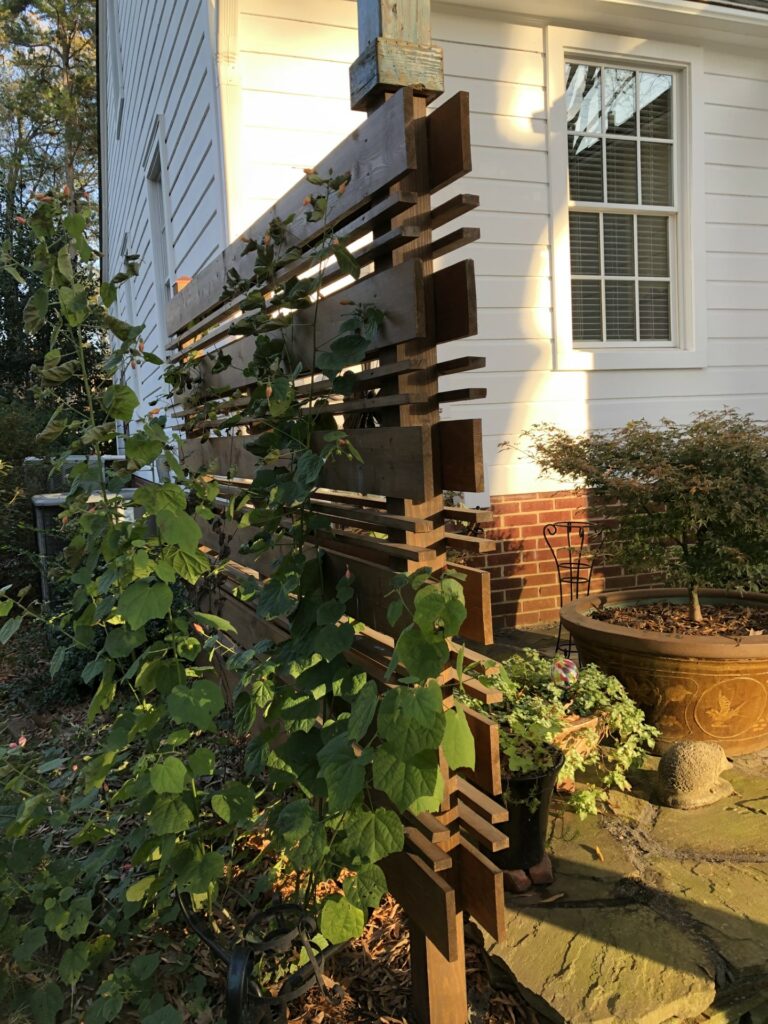
This structure provides an architectural element behind a patio and support for a climbing vine. (Photo by Lynn Calder.)
To maximize your space, use vertical placement of plants: consider hanging baskets from the ceiling or posts, attaching trellises to walls and boxes to railings, and using plant stands. You can cover railings with chicken wire to support vines or climbing plants. Be sure to check any management restrictions related to weight limits, attaching structures to outside walls, placing containers on railings or hanging plants from hooks.
Notice how your patio, deck or balcony garden will look from inside your home too. Not only can you enjoy a garden just outside your door, but plants like tall evergreens or a flowering vine growing on a trellis can help provide privacy or block an unsightly view like a parking lot.
Filling Containers with Potting Soil
Use a good quality potting mix formulated for containers to retain moisture and drain well. You never want to use garden soil; it is too heavy, has little pore space and may harbor diseases, insects and weeds. Commercial potting mixes usually contain no soil at all. Some mixes are marketed for specific plant needs, such as a succulent or cactus mix which will retain less moisture.
When filling the container, loosely fill the pot with moistened (not wet) potting mix — don’t pack it down. Leave about a 1/4-inch to 3-inch space between the top of the soil and rim of the pot to allow space for watering without the water immediately running over the edge. The larger the pot, the more space is needed at the top.
Tip for Using Less Potting Mix: As long as you have enough soil for root growth, you can reduce weight and the amount of potting mix needed for large containers by filling the bottom quarter with a light-weight inert bulk material. Lay a piece of landscape fabric over the top of the material and fill the rest with potting soil. The landscape fabric allows water to pass through but keeps the soil intact.
Choosing and Placing Plants in Containers
Plant seeds and transplants in containers at about the same time you would in the ground. Select plants with similar light, water and nutrient requirements for the same container and follow planting instructions on seed packages or plant tags.
Placement of plants in containers is often based on the “thriller, spiller, filler” technique: place a taller plant in the center of the container for height, then use shorter and trailing plants toward the edge. You can add bushy, medium height plants to fill in the spaces in between. Plants labeled as compact, bush, dwarf or miniature and pest and disease resistant are the best choices for containers. Be careful not to overpack the container with new plants. Leave space for the plants — and their roots — to grow!
Place plants in the container so that roots are not exposed but the plant’s base (where the roots meet the stem) is not buried. Shake the pot gently to evenly spread out the mix around the plant. Water the newly potted plant thoroughly; this will settle the plant and potting mix. Topping the mix with mulch will provide a finished look and help retain moisture. See these tips for planting hanging baskets.
Caring for Container Gardens
Most potting mixes contain a small amount of fertilizer to jump-start growth of newly potted plants. Once plants being growing, apply an appropriate fertilizer depending on the plant’s needs. For example, slow-release fertilizers are convenient but may release nutrients too slowly for fast-growing vegetables; native plants will need very little fertilization. Compost may also be added for nutrients and good soil biology.
Tips for Watering: Test your containers for dryness by inserting your finger in the potting mix two to three inches; if it’s dry, the plant needs to be watered. Containers should not dry out completely. Preferably water in the morning, filling with water to the edge of the rim until water drains from the bottom. Use a saucer or tray under plants to keep water from running onto your neighbor’s balcony. Empty the excess water from saucers to keep salt from building up in the container and discourage mosquito growth.
You’ll need to decide what you want to do with your container plants over the winter. Some plants will survive outdoors but must be in frost-proof pots that are well-insulated or protected so the soil maintains moisture but doesn’t freeze. Plants that can tolerate cold weather in our area include some hardy annuals (pansies) and perennials, cool weather vegetables (collards and kale), some herbs (bay and rosemary) and evergreens (hollies, boxwoods and ivy).
Tender plants should either be discarded and composted or moved indoors once temperatures drop to 55 degrees at night. If you’re going to bring plants inside, acclimatize them over about a week by first moving them to a shaded area or a covered porch or shed. Indoors, place the plants away from drafts in a location where they will receive the proper light if possible.
Containers that would be damaged by freezing and thawing conditions should be brought inside or emptied of plants and soil, cleaned and stored upside down.
Attracting Wildlife
Even a small container garden can attract pollinators and birds. Search out native plant varieties that will attract bees and butterflies and will flourish in your garden’s environment. Consider adding a bird feeder or two (including a hummingbird feeder) and a vessel to provide water for your visiting wildlife.
Then sit back and enjoy your small garden and the wildlife it attracts!
Additional Resources:
- Container Gardens, Illinois Extension (series of web pages about creating, planting and maintaining container gardens with a variety of plants)
- Balcony Garden Basics, Master Gardeners of Northern Virginia (Virginia Cooperative Extension)
- How to Create a Container Garden for Edibles in the North Carolina Piedmont, NC State Extension (includes a table of vegetables with light, water and nutrient requirements)
- Contained Excitement: Outdoor Container Garden Basics & What’s Trending! Master Gardeners of Northern Virginia (Virginia Cooperative Extension) (Video and extensive list of resources)
Train to be a Master Gardener Volunteer
Interested in becoming a Master Gardener volunteer in Orange County? We help people in our county learn about plants and gardening, using research-based information.
A training class for new volunteers will start in September 2024. The class meets weekly (a three-hour session) for 14 weeks. You’ll learn about plants, plant diseases, insects, soil, good gardening practices and other topics. Previous gardening experience is welcome but not required.
After volunteers complete the course, they provide at least 30 hours of volunteer work and obtain at least 10 hours of continuing education each year. We have a wide variety of interesting volunteer opportunities. Click here to join our contact list so that you can receive more information about the class as it becomes available. We hope you’ll join us!
Dig Deeper
Learn more about gardening at our next Dig Deeper talk on Saturday, March 23, 2 to 3:30 p.m., at the Orange County Library in Hillsborough. (Please register on the library’s website.) Master Gardener volunteer Mary Paulsgrove will present “Insects & Diseases in the Garden.”
Check us out!
- Have a plant or garden question? Email the Orange County Master Gardener volunteers at ocmgardeners@gmail.com or phone 919-245-2061.
- Subscribe to The Garden Buzz, the Orange County Master Gardeners’ monthly newsletter, for gardening news and tips. And visit our website, The Orange Gardener, for helpful gardening information and tips.
- Follow us on Facebook! Our page is Orange County NC Extension Master Gardener Volunteer.
Chapelboro.com does not charge subscription fees, and you can directly support our efforts in local journalism here. Want more of what you see on Chapelboro? Let us bring free local news and community information to you by signing up for our newsletter.


